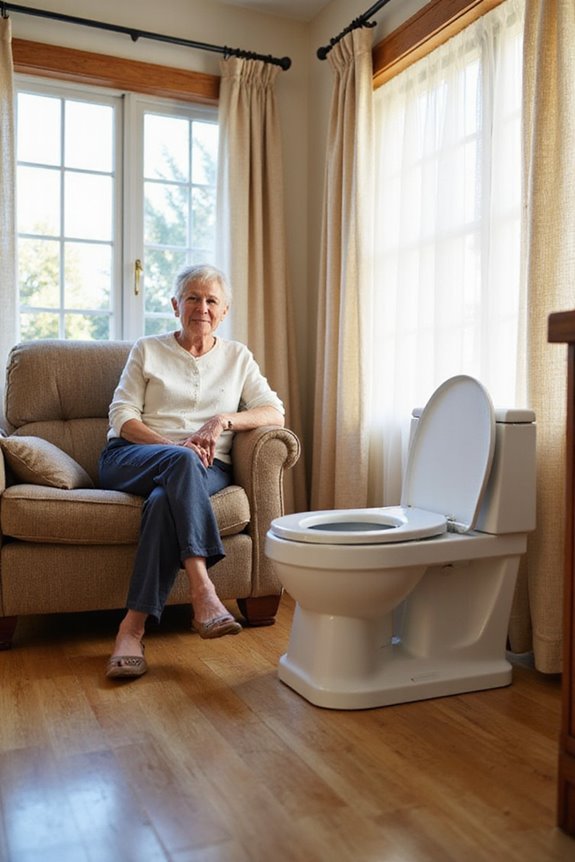A three-in-one commode operates as a commode, raised toilet seat, and toilet safety frame. Its primary functions include enhancing safety and accessibility for individuals with mobility challenges. The commode features durable materials, such as aluminum and steel, providing stability and strength. Adjustable seat height, ranging from 15.5” to 23.5”, accommodates various users. Essential for both clinical and home settings, its design reduces fall risks and improves hygiene. Additional details on its functionality and adaptability await exploration.
Key Takeaways
- A 3-in-1 commode functions as a commode, raised toilet seat, and toilet safety frame for enhanced accessibility.
- It features adjustable height settings, accommodating users with varying mobility needs and promoting safer transfers.
- Designed with durable materials like aluminum and steel, it ensures stability and longevity in both clinical and home environments.
- The lightweight and foldable design allows for easy transport and reduces nighttime walking distance for older adults.
- Non-slip feet and arm supports enhance safety, minimizing fall risks for users with balance issues.
Definition and Primary Functions
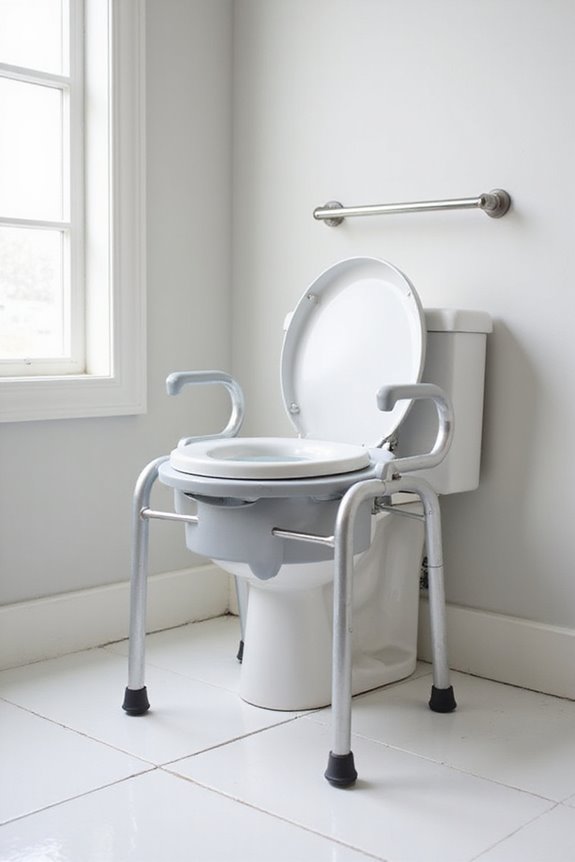
A 3-in-1 commode serves as a versatile toileting solution, combining multiple functions into a single device. This portable commode fulfills three primary toileting functions:
- Commode Function: Functions as a freestanding unit with a removable bucket for convenient waste disposal.
- Raised Toilet Seat Function: Increases toilet height, assisting users in sitting down and standing up safely.
- Toilet Safety Frame Function: Provides stability and support around a traditional toilet, minimizing fall risks.
Designed for both clinical and home environments, these devices enhance accessibility and promote independence among users, particularly older adults and individuals with mobility challenges. Safety features such as adjustable height and non-slip feet further guarantee a secure experience, making the 3-in-1 commode an essential tool for effective toileting functions. Additionally, many models provide adjustable height settings to cater to various user preferences, ensuring comfort and usability.
Construction and Materials
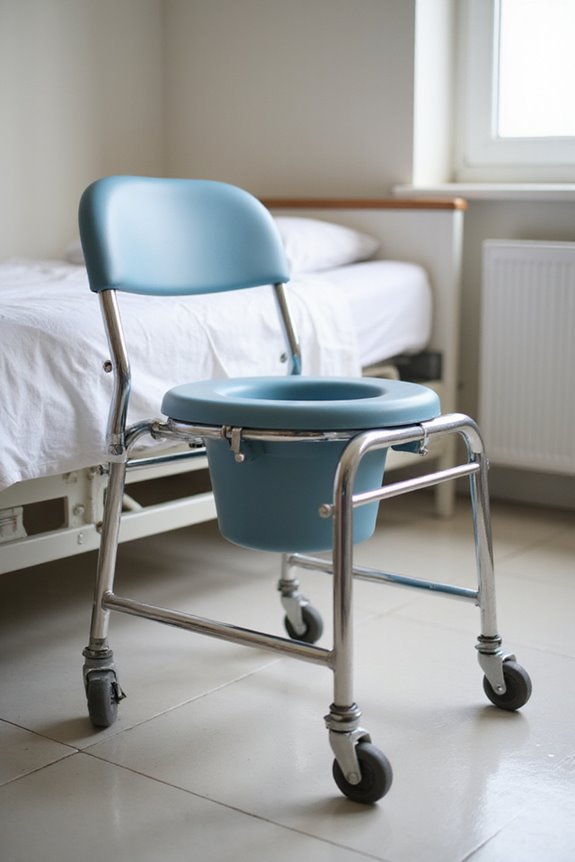
Construction and materials play a crucial role in the functionality and longevity of a 3-in-1 commode. Material selection, including aluminum, steel, and PVC, dictates the durability factors critical for different usage scenarios.
- Steel offers exceptional strength, suitable for high-traffic environments.
- Aluminum strikes a balance between weight and durability, enhancing maneuverability.
- PVC provides waterproof characteristics, essential for bathroom settings.
Additionally, the structural integrity is often reinforced through welding, which boosts longevity. Portability considerations are evident in the design, with folding and wheeled options catering to various user needs. Each material’s resistance to corrosion also contributes to the commode’s overall lifespan, ensuring reliable performance under daily use.
Design Features and Specifications
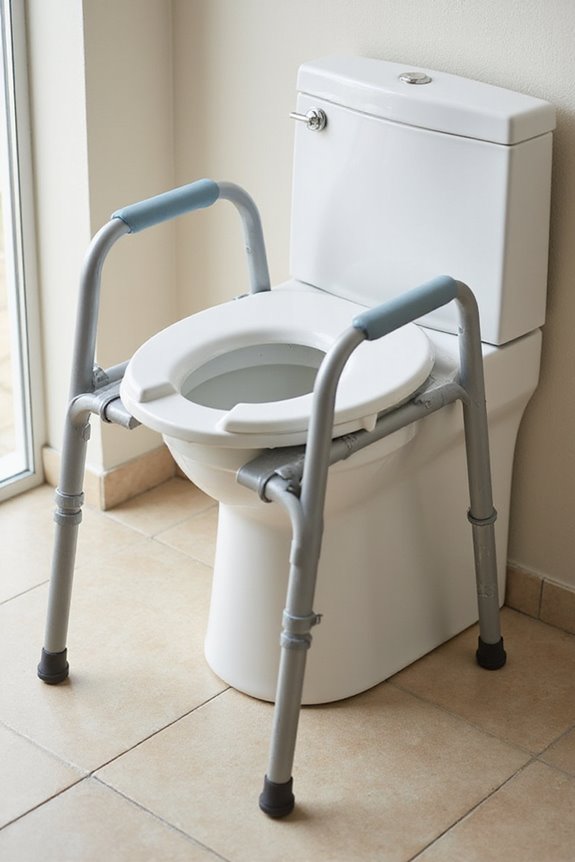
Design features and specifications are integral to the effectiveness and versatility of a three-in-one commode.
Design Versatility
- Functions as a free-standing commode, a toilet safety frame, and a raised toilet seat.
- Removable back for varied configurations; tool-free assembly enhances user convenience.
- Includes a commode bucket, splash guard, and lid for extensive functionality.
Adjustable Features
- Seat height adjusts in one-inch increments, ranging from 15.5” to 23.5” for standard models.
- Bariatric versions support weight capacities of up to 450 lb.
Dimensions and Capacity
– Typical outside width is 24 inches; seat dimensions are 13.5” width by 16.5” depth.
Mobility
– Lightweight designs allow for easy transport and placement, catering to diverse user needs.
Clinical and Safety Benefits

Enhanced Patient Safety
- Elevated seating height reduces fall risks during transfers.
- Arm supports offer stability for sitting and standing.
- Mobility features decrease the need for multiple transfers.
- The use of transfer benches, which provide enhanced stability during bathing, can further mitigate risks for patients with limited mobility.
Reduced Caregiver Strain****
- Adjustable height promotes ergonomic postures for caregivers.
- One device facilitates toileting tasks, minimizing lifting.
- Mobile commodes allow bedside assistance, preventing injuries.
Improved Hygiene
- Commode pans enable effective management of bowel and urinary needs.
- Easy removal lowers infection risks through better sanitization.
- Consistent toileting schedules reduce incontinence episodes.
These features collectively enhance patient safety, reduce caregiver strain, and promote better clinical outcomes, ensuring a dignified care experience for all involved.
Usage and Adaptability
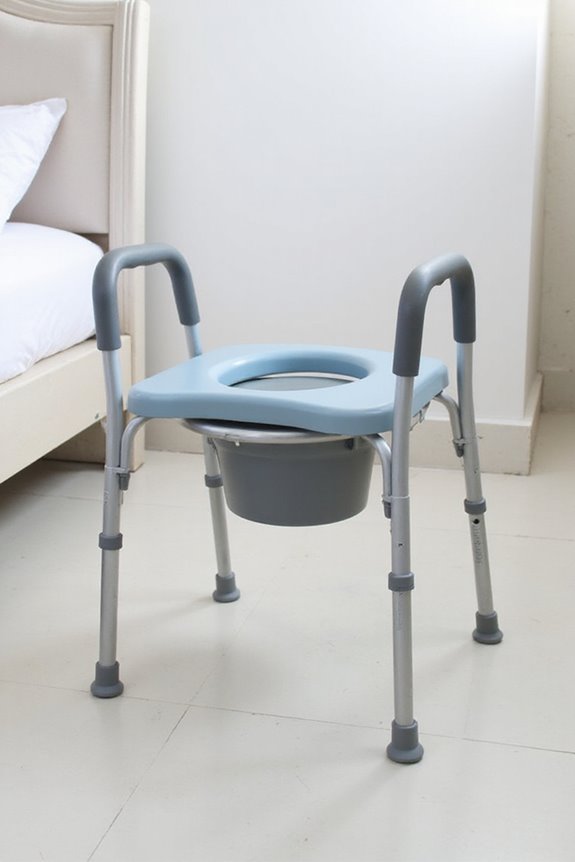
Three-in-one commodes offer exceptional versatility, adapting seamlessly to various user needs across different environments. Their home adaptability is evident in multiple configurations, serving as bedside commodes, raised toilet seats, or toilet safety frames.
Key features include:
- Portability: Lightweight and foldable for easy movement and storage.
- Nighttime Accessibility: Reduces the distance older adults must walk at night.
- Shower Use: Some models double as shower stools.
- Adjustable Features: Height-adjustable legs cater to diverse user preferences.
With removable buckets for easy cleaning and non-slip feet for stability, these commodes effectively address the requirements of users with mobility or balance issues, enhancing independence and comfort in various settings. Additionally, many models include safety features designed to prevent tipping and enhance user stability.
Market and Product Variability
The market for commode chairs is characterized by significant variability, driven by diverse user needs and preferences. Current consumer trends indicate a growing demand for 3-in-1 designs, which enhance flexibility by serving as toilets, commodes, and shower seats.
Key statistics highlight the following:
- The global hospital commode market is projected to grow from USD 844.23 million in 2023 to USD 1,596.19 million by 2030, reflecting a CAGR of 8.29%.
- Aging populations and the rise of mobility issues are primary drivers of market growth.
- Product differentiation includes manual versus smart commodes, and features like adjustable height and health monitoring capabilities.
This variability allows consumers to select products that align with their specific needs and preferences.
Frequently Asked Questions
How Do I Clean a 3-In-1 Commode Properly?
Cleaning a 3-in-1 commode properly involves effective cleaning techniques, including thorough disinfection of all surfaces, and maintenance tips like regular inspections and utilizing liners to enhance hygiene, ensuring a safe and comfortable environment for users.
Can a 3-In-1 Commode Be Used Outdoors?
A three-in-one commode can indeed be utilized outdoors, thanks to its portability features. While not designed for prolonged outdoor exposure, its convenient design allows for temporary outdoor usage during events or emergencies with proper care.
What Weight Limit Should I Consider for My Needs?
When evaluating weight considerations, individuals should prioritize user safety by selecting a weight limit that exceeds their body weight by at least 50 pounds, ensuring durability and preventing potential equipment failure during use.
Are There Any Specific Brands Recommended for Elderly Care?
Several commode brands are recommended for elderly products, including Medline, Drive Medical, and Platinum Health. These brands are recognized for their comfort, durability, and safety features, ensuring a supportive experience for elderly users in need.
How Can I Ensure My Commode Is Stable During Use?
Like a sturdy bridge spanning a river, ensuring commode stability requires level adjustments, flat surfaces, and secure components. Prioritizing user safety through careful maintenance and awareness fosters confidence and comfort in daily routines.

